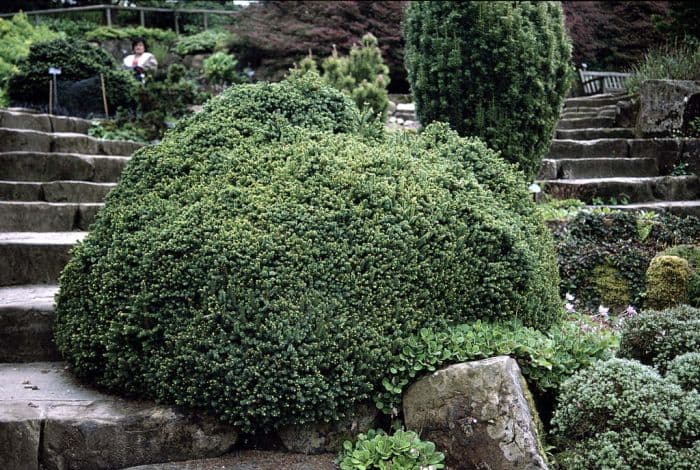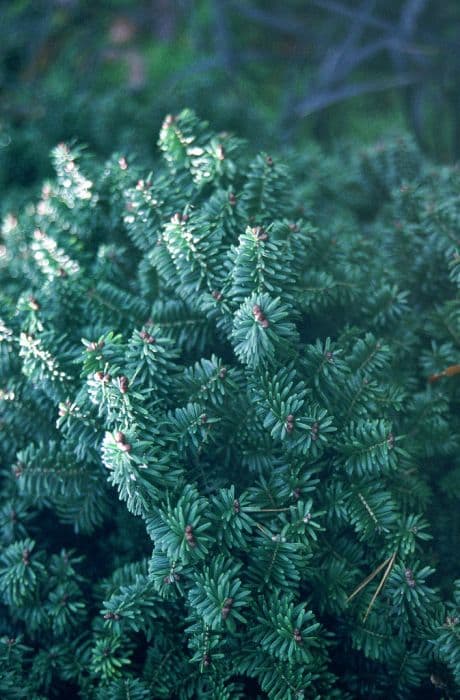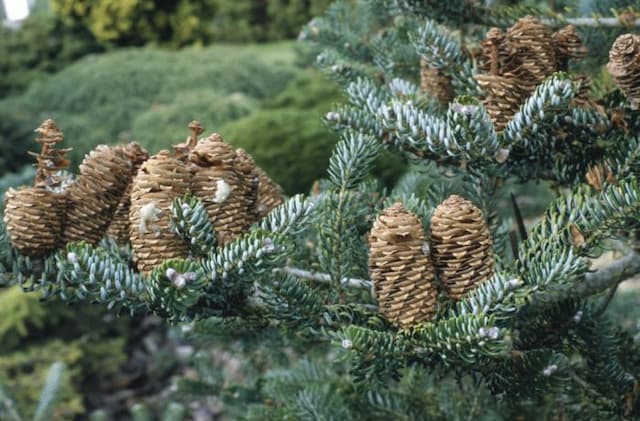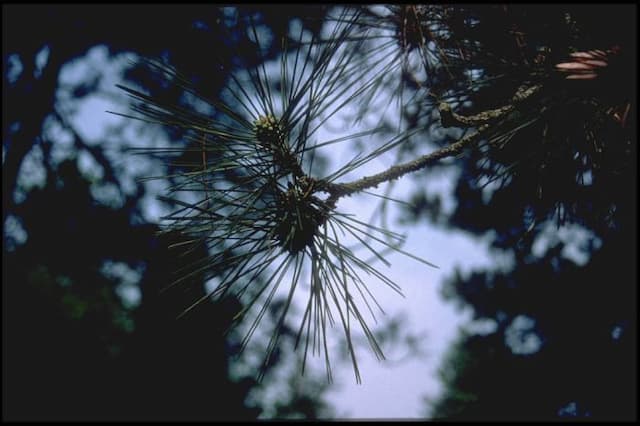Black Spruce Picea mariana 'Nana'

ABOUT
The plant commonly known as Black Spruce 'Nana' is a compact and dense evergreen conifer. This plant boasts a naturally symmetrical, globe-shaped habit that provides year-round interest in the landscape. The needles are short, stiff, and a deep, dark green hue that sometimes appears blueish-green under certain lighting conditions. These needles densely cover the upwardly angled branches, creating a full and plush appearance. As a cultivar of Black Spruce, 'Nana' has the characteristic flaky, thin bark that may be gray to a reddish-brown in color. During the growing season, it may produce small, inconspicuous cones that start off purplish but mature to a brown color, hanging pendulously from the branches. The overall texture of the plant is fine, yet it presents a sturdy and rugged appearance that is well-suited to cold environments where it can be seen with a dusting of snow resting on its branches, accentuating its form and adding to its charm in garden landscapes.
About this plant
 Names
NamesFamily
Pinaceae.
Synonyms
Dwarf Black Spruce, Nana Black Spruce, Nana Canadian Spruce.
Common names
Picea mariana var. semiprostrata, Picea brevifolia, Picea mariana f. semiprostrata.
 Toxicity
ToxicityTo humans
Black spruce, commonly known as Picea mariana 'Nana', is not generally considered toxic to humans. Ingesting parts of the plant is not known to cause serious harm. However, as with many plants, individual allergies or sensitivities could result in mild irritation or discomfort.
To pets
Black spruce, commonly known as Picea mariana 'Nana', is not generally considered toxic to pets. It isn't associated with poisoning in domestic animals, and consuming parts of the plant typically does not lead to serious health issues. However, pets may experience mild gastrointestinal upset if they ingest significant quantities of non-food plants, black spruce included.
 Characteristics
CharacteristicsLife cycle
Perennials
Foliage type
Evergreen
Color of leaves
Green
Height
3 feet (0.91 meters)
Spread
3 feet (0.91 meters)
Plant type
Shrub
Hardiness zones
2
Native area
North America
Benefits
 General Benefits
General Benefits- Landscape Aesthetics: Black Spruce 'Nana' is known for its dense, compact growth and conical shape, which adds visual interest and a classic evergreen presence to gardens and landscapes.
- Wildlife Habitat: This plant provides shelter and nesting sites for various species of birds and small animals.
- Low Maintenance: Black Spruce 'Nana' is relatively easy to care for, requiring minimal pruning and maintenance once established.
- Cold Tolerance: It is extremely hardy and can withstand very cold temperatures, making it suitable for northern climates and high-altitude landscapes.
- Soil Adaptation: This plant is adaptable to a range of soil types, although it prefers moist, acidic soils.
- Drought Resistance: Once established, Black Spruce 'Nana' can tolerate periods of drought, making it suitable for regions with occasional water restrictions.
- Windbreak: This plant can be used in windbreak plantings to reduce wind speed and protect more sensitive plants or structures.
- Erosion Control: The root system of Black Spruce 'Nana' helps stabilize soil and prevent erosion on slopes or in areas with loose soil.
- Privacy Screening: With its dense growth habit, it can be used as a privacy screen or living fence.
- Seasonal Interest: Although an evergreen, Black Spruce 'Nana' offers year-round interest, with needle color sometimes intensifying during colder months.
 Medical Properties
Medical PropertiesThis plant is not used for medical purposes.
 Air-purifying Qualities
Air-purifying QualitiesThis plant is not specifically known for air purifying qualities.
 Other Uses
Other Uses- Picea mariana 'Nana', commonly known as Dwarf Black Spruce, can be used as a bonsai plant for enthusiasts who appreciate miniature versions of trees and the art of bonsai cultivation.
- Wood from the Dwarf Black Spruce can be crafted into specialized musical instruments such as soundboards for violins or other string instruments, due to its acoustic properties.
- The needles of the Dwarf Black Spruce can be used in the production of essential oils for use in aromatherapy, candles, and natural cleaning products.
- The dense and compact nature of Dwarf Black Spruce makes it an excellent choice for creating windbreaks in landscape design, particularly in colder climates.
- Branches and foliage can be harvested to create natural holiday wreaths and other festive decorations during the winter season.
- Fine wood shavings from Dwarf Black Spruce can be used as a natural mulch or soil conditioner for gardens, helping to regulate temperature and moisture levels.
- The resin from Dwarf Black Spruce can be utilized in the manufacturing of specialized adhesives or as a natural, traditional sealant for boats and other wooden structures.
- Sawdust from the Dwarf Black Spruce, when compressed, can be made into eco-friendly wood pellets used for home heating systems.
- In photography and cinematography, Dwarf Black Spruce can be used in outdoor set designs to evoke certain atmospheric conditions or to mimic a specific type of forest scene.
- Needles and twigs can be scattered in small animal enclosures to provide natural bedding and to recreate the animal's native forest floor environment.
Interesting Facts
 Feng Shui
Feng ShuiThe Black Spruce is not used in Feng Shui practice.
 Zodiac Sign Compitability
Zodiac Sign CompitabilityThe Black Spruce is not used in astrology practice.
 Plant Symbolism
Plant Symbolism- Resilience: Black Spruce 'Nana' symbolizes resilience due to its ability to thrive in harsh, cold environments.
- Purification: It represents purification because many cultures have used the plant in cleansing rituals and for its antiseptic properties.
- Longevity: This plant is symbolic of longevity because spruce trees can live for many years, reflecting endurance and persistence.
- Protection: Black Spruce 'Nana' may be seen as a symbol of protection; in some traditions, spruce branches were used to ward off evil spirits.
 Water
WaterDwarf Black Spruce requires consistent moisture, particularly during its first few years after planting. Water the plant deeply once a week, providing at least one inch of water which equates to about 0.6 gallons for young plants, ensuring that moisture reaches the root zone. During periods of drought or extreme heat, increase watering to twice a week. Avoid allowing the soil to become waterlogged, as this can lead to root rot. Adjust the watering schedule during the winter months when the plant is dormant, reducing the amount to when the soil feels dry to the touch.
 Light
LightDwarf Black Spruce thrives in full sunlight to partial shade. It prefers to be positioned in a location where it can receive at least four to six hours of direct sunlight each day. An ideal spot would be one that offers morning sunlight and protection from the intense afternoon sun, particularly in the hottest parts of the year.
 Temperature
TemperatureDwarf Black Spruce is hardy and can tolerate cold temperatures, making it suitable for a range of climates. The ideal temperature range for this plant is between -40 degrees Fahrenheit and 70 degrees Fahrenheit. It can survive extreme cold down to -50 degrees Fahrenheit, ensuring it is well-suited for northern climates.
 Pruning
PruningPruning Dwarf Black Spruce is generally not required as it maintains its compact shape naturally. However, if shaping is desired or to remove damaged or diseased branches, pruning should be done in late winter or early spring before new growth begins. Prune sparingly to maintain the plant's natural form and avoid cutting into the older wood, which may not regenerate.
 Cleaning
CleaningAs needed
 Soil
SoilBlack Spruce 'Nana' prefers well-draining, acidic soil with a pH range of 4.0 to 6.0. A good soil mix consists of peat moss, sand, and loamy soil to ensure proper drainage and mimic its natural habitat.
 Repotting
RepottingBlack Spruce 'Nana', a slow-growing dwarf conifer, typically needs repotting every 3 to 4 years, as it does not outgrow its container quickly.
 Humidity & Misting
Humidity & MistingBlack Spruce 'Nana' is adaptable to a wide range of humidity levels but does best in moderate humidity; avoid excessively dry indoor air.
 Suitable locations
Suitable locationsIndoor
Place in cool room with bright, indirect light.
Outdoor
Full sun to partial shade; protect from strong winds.
Hardiness zone
2-6 USDA
 Life cycle
Life cycleThe Picea mariana 'Nana,' commonly known as the Black Spruce 'Nana' or Dwarf Black Spruce, begins its life cycle with seed germination, typically occurring in moist, cool conditions. The seedling stage follows, where it develops a central stem and primary leaves as it establishes a root system. As a juvenile, the plant starts to grow into a compact, dwarf evergreen shrub, producing needles and developing a woody stem. During its mature phase, the Dwarf Black Spruce 'Nana' reaches its full size (usually not exceeding 3-6 feet in height), and it can begin to reproduce, forming cones that contain the seeds; in optimal conditions, cones are produced annually or biennially. It possesses a slow growth rate and can live for many decades, during which it may face cycles of growth and dormancy, aligned with seasonal changes. In the final stage of its life, the plant may experience a decline in vigor, leading to reduced foliage and cone production, eventually dying either due to environmental factors or natural senescence.
 Propogation
PropogationPropogation time
Early spring
The Black Spruce 'Nana', a dwarf variety of Picea mariana, is most commonly propagated through seed sowing or by taking semi-hardwood cuttings. The most popular method is through semi-hardwood cuttings, which are typically taken in the summer months, from June to August, when the new growth has begun to mature. To propagate Black Spruce 'Nana' using this method, cuttings of about 4 to 6 inches (10 to 15 centimeters) in length are taken from healthy, disease-free parent plants. It's essential to include several sets of needles and to make the cut just below a node. The cut end of the cutting is then dipped in rooting hormone to encourage root development and planted in a well-draining soil mix. The cuttings should then be kept in a humid environment with indirect light until roots have developed, which usually takes several weeks to a few months.









